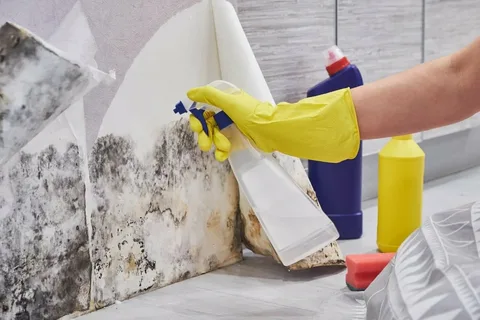Mould is more than just an eyesore; it poses severe risks to your health and the integrity of your home. In Sydney’s humid climate, mould can flourish unexpectedly, transforming a minor issue into a major emergency. Whether it’s lurking behind walls or creeping along ceilings, understanding how to tackle this menace is crucial for every homeowner. This essential guide will equip you with everything you need to know about Emergency Mould Remediation Sydney —from identifying the signs that demand immediate action to effective prevention strategies that keep your living space safe and healthy. So, let’s dive in and arm yourself with knowledge before those pesky spores take over!
Understanding the Risks of Mould
Mould isn’t just a household nuisance; it can have severe implications for your health. Mould spores can lead to respiratory issues, allergies, and even chronic conditions in sensitive individuals. Those with asthma or compromised immune systems are particularly at risk.
Beyond health concerns, mould can cause significant structural damage to your home. It feeds on organic materials like wood and drywall, weakening these essential components over time. Ignoring the problem allows it to spread, leading to costly repairs.
Additionally, mould growth may affect property values and complicate insurance claims. Many insurers require proof of proper remediation when handling claims related to water damage or mould infestations. Understanding these risks is crucial for maintaining a safe living environment in Sydney homes amidst its humid climate.
Common Causes of Mould in Sydney Homes
Mould growth is expected in many Sydney homes due to the humid climate and frequent rainfall. When moisture accumulates in areas with poor ventilation, it creates the perfect environment for mould to thrive. Understanding the critical causes of mould can help homeowners take preventive measures to protect their homes and health. Here are some of the most common causes of mould in Sydney homes:
High Humidity Levels
Sydney’s high humidity, especially during warmer months, provides ample moisture for mould growth. Homes that aren’t well-ventilated are particularly susceptible to this issue.
Leaky Pipes or Roofs
Leaking pipes or damaged roofs allow water to seep into walls and ceilings, creating hidden moisture areas where mould can quickly grow.
Poor Ventilation
Without adequate airflow, moisture from everyday activities like cooking, showering, and drying clothes can build up indoors, leading to mould growth in corners or behind furniture.
Flooding and Water Damage
Flooding from heavy rains or plumbing issues can cause significant water damage, providing the perfect conditions for mould development.
Condensation
Condensation on windows, walls, and ceilings occurs when warm, moist air meets more excellent surfaces. This trapped moisture encourages mould growth, particularly in poorly insulated homes.
Signs You Need Emergency Remediation
Mould can spread quickly, so recognizing the signs early is crucial. If you notice a musty odour in your home, it’s often a strong indicator of mould lurking nearby. This smell usually means that moisture has accumulated somewhere, providing an ideal environment for growth.
Visible patches or stains on walls, ceilings, and floors are also red flags. These dark spots may appear greenish-black or even grey and are clear signs that mould might be present. Don’t ignore these warnings; prompt action can prevent further damage to your property.
Additionally, watch for unexplained health issues among household members. Symptoms like coughing, sneezing, or skin irritations can signal exposure to mould spores. If you experience these symptoms alongside other indicators listed here, immediately seek emergency remediation services in Sydney.
Choosing a Reliable Remediation Service
Choosing an exemplary remediation service is crucial for effective mould removal. Look for companies with extensive experience in emergency mould remediation in Sydney. Those in the industry for several years typically understand local regulations and best practices.
Check reviews and testimonials to gauge previous clients’ experiences. A company with a solid reputation will often provide case studies or references showcasing its success rates. Don’t hesitate to ask about its methods and certifications, as this demonstrates professionalism.
Get multiple quotes before making a decision. Compare not just prices but also the services included in each quote. Transparency regarding costs, processes, and timeframes can indicate how reliable a service is when eliminating mould effectively from your home.
Preparing Your Home for Remediation
Preparing your home for emergency mould remediation ensures a smooth process. Start by clearing the area of any furniture, decor, or personal items that might obstruct the remediation team’s access. This helps protect your belongings and allows the professionals to work efficiently.
Next, turn off any HVAC systems and ventilation fans in affected areas. This prevents spores from spreading throughout your home during the removal process. If possible, barriers can be created using plastic sheeting around contaminated zones to further contain mould particles.
Inform everyone in your household about what’s happening. Family members and pets should stay away from affected areas until remediation is complete. Keeping communication open will help everyone feel more at ease during this challenging time.
The Remediation Process Step by Step
The remediation process begins with a thorough assessment. Professionals inspect your home to identify the extent of mould growth and assess any underlying water issues. This initial evaluation is crucial for developing an effective plan.
Next, containment measures are implemented. They seal off affected areas to prevent spores from spreading throughout your home. Negative air pressure may be established to control airborne particles further.
After containment, the actual removal begins. Technicians use specialized equipment and techniques to eliminate mould from surfaces safely. Cleaning agents or biocides might be applied as needed. Once removed, they will clean and disinfect all affected materials, ensuring your home returns to a safe environment free of contaminants.
Equipment Used in Mould Removal
Effective mould removal relies on specialized equipment designed to tackle the problem efficiently. High-efficiency particulate air (HEPA) vacuums are essential for capturing tiny mould spores that regular vacuums can miss. These powerful machines help ensure that contaminants don’t spread during remediation.
Dehumidifiers play a crucial role in maintaining optimal humidity levels throughout the operation. By reducing moisture in the air, they create an unfavourable environment for mould growth, aiding in both removal and prevention.
Negative air machines are another vital tool used by professionals. They filter out airborne particles while creating negative pressure in affected areas, preventing spores from migrating to clean spaces. This layered approach ensures thorough mould eradication and effectively helps restore your home’s safety.
Addressing Health Concerns During Remediation
Health concerns can arise during the remediation process when dealing with mould. Mould spores are airborne and can lead to respiratory issues or allergies. It’s crucial for those sensitive to these spores to take precautions.
Before starting any work, ensure that vulnerable individuals—like children, elderly family members, or those with pre-existing conditions—are safely relocated. This minimizes their exposure while the job is underway.
Professional remediation teams often use protective gear such as masks and gloves. They should also employ containment strategies to prevent the spread of mould particles throughout your home. Always communicate openly with your chosen service about safety measures they will implement during the process.
Preventing Mould Regrowth
Preventing mould regrowth is essential for maintaining a healthy home. After remediation, focus on controlling moisture levels in your environment. Invest in dehumidifiers to keep humidity below 60%. This simple step can significantly reduce the likelihood of mould returning.
Regular cleaning also plays a crucial role. Use vinegar or baking soda solutions to wipe down surfaces prone to dampness, like bathrooms and kitchens. Pay attention to areas often unnoticed, such as behind appliances or under sinks.
Ensure proper ventilation throughout your home. Open windows when weather permits and use exhaust fans while cooking or showering. Consider installing air vents where necessary. By staying proactive about these factors, you’ll create an inhospitable environment for mould spores and protect your living space long-term.
The Role of Ventilation and Humidity Control
Proper ventilation is crucial in preventing mould growth. Stagnant air creates a perfect environment for spores to settle and thrive. By ensuring consistent airflow, you can significantly reduce moisture levels in your home, making it less inviting for mould.
Humidity control plays an equally important role. Ideal indoor humidity levels range between 30% and 50%. When humidity rises above this threshold, the risk of mould increases dramatically. Using dehumidifiers or air conditioning systems can help maintain these optimal conditions.
It is also essential to regularly check areas prone to dampness—like bathrooms, kitchens, and basements—for excess moisture. Installing exhaust fans or opening windows during cooking or showering allows excess moisture to escape easily. These simple practices create a less hospitable environment for unwanted mould growth in your Sydney home.
Costs Associated with Sydney Mould Remediation
Costs for Sydney Mould Remediation can vary widely. Factors influencing the price include the extent of the mould infestation, the type of materials affected, and accessibility. Generally, homeowners can expect to pay anywhere from a few hundred to several thousand dollars.
Professional services typically charge based on square footage or an hourly rate. Additional fees may arise if extensive structural repairs are needed after removal. It’s essential to get detailed quotes beforehand to understand what is included.
Insurance coverage also affects overall costs. Some policies cover mould damage, while others don’t. Check your policy thoroughly before proceeding with remediation services to know what financial assistance you might receive during this challenging time.
Long-Term Maintenance Tips
Maintaining a mould-free home requires ongoing attention. Regular inspections in high-risk areas, like bathrooms and basements, can help catch early signs of moisture or mould growth. Look for leaks or water damage that could jeopardize your home’s health.
Keep humidity levels low by using dehumidifiers where necessary. Aim for indoor humidity between 30-50%. This simple adjustment will significantly reduce the likelihood of mould returning. Don’t forget about ventilation! Ensure proper airflow throughout your space by opening windows and using exhaust fans during cooking or showering. Good ventilation keeps air circulating and helps prevent damp conditions conducive to mould growth. Staying proactive is critical to long-term success in mould prevention.
Conclusion
Addressing mould issues promptly is crucial for maintaining a healthy home environment. Emergency Mould Remediation Sydney isn’t just about removing visible spores; it’s about ensuring the safety and comfort of your living space. Investing time and resources into proper remediation can save you from more significant problems. Understanding the risks, causes, and signs of mould will empower you to take action when needed. Moreover, regular maintenance and preventative measures are vital to keeping your home free from unwanted moisture. By staying vigilant and informed, you’re setting yourself up for long-term success against mould growth.
FAQs
What should I do if I find mould in my home?
Don’t panic! Start by identifying the source of moisture and containing the area as much as possible. Then, call a professional for immediate assessment and remediation.
How long does mould removal take?
The duration varies based on the extent of growth and damage. Generally, minor cases can be resolved within a day or two, while more severe infestations might require several days.
Will my insurance cover mould remediation?
Coverage depends on your policy specifics. Many homeowners’ policies include provisions for mould damage caused by sudden incidents like leaks but exclude wear-and-tear scenarios.
Can I remove the mould myself?
While DIY methods exist, they often fail to eradicate the issue or ensure safety ultimately. Professionals use specialized equipment and techniques that are far more effective in guaranteeing complete removal.
What preventive measures can I take after Sydney Mould Remediation?
Focus on controlling humidity levels, improving ventilation, and promptly fixing leaks after Sydney Mould Remediation. Regular inspections will also help catch potential issues before they escalate into emergencies.
| Related Business Listings |
| Contact Directory |
| Local Business Profiles |





